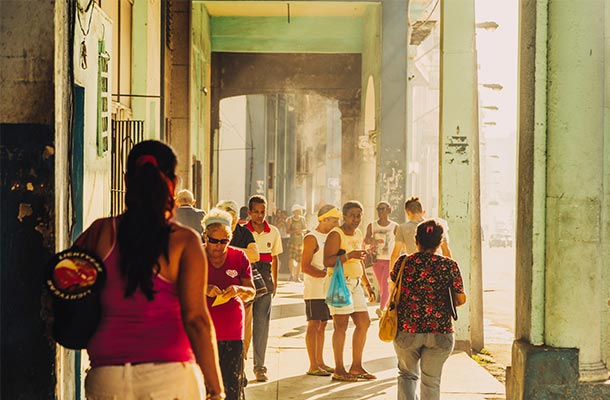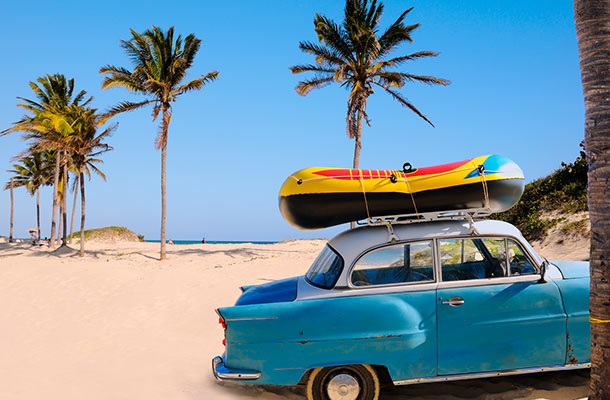With its stunning beauty, fascinating history, and soul-stirring music, Cuba is one of the hottest destinations on the planet. Our Cuba Insider gives you the must-see destinations on this Caribbean island.
 Photo © iStock/Nikada
Photo © iStock/Nikada
- Old Havana
- Cuba Beaches
- Museo Nacional de Bellas Artes de la Habana
- Che Guevara Mausoleum, Santa Clara
- Morro Castle, Havana
- Gran Teatro de la Habana
- El Capitolio, Havana
- Museum of the Revolution, Havana
- Castillo de San Pedro de la Roca, Santiago de Cuba
- Hemingway Museum, Havana
- Must-see Cities in Cuba
Old Havana
Built by the Spanish conquerors of Cuba, the historic core of Old Havana dates back to the 16th century. Beautifully restored (in parts), Old Havana brims with cobblestoned plazas, bougainvillea-framed mansions, handsome porticos, frescoes, churches, museums and - in the last six years - a raft of private restaurants, bars and shops.
Cuba Beaches
Cuba's beaches are postcard-perfect, fringed by palm trees, sparkling with white sands, and lapped by stunning turquoise water. The best include those on the north coast at Varadero, Cayo Santa Maria, Cayo Guillermo, Cayo Coco, Guardalavaca, Saetia, Maguana, Punta Frances (Isla de la Juventud), and Cayo Jutias and Cayo Levisa in western Cuba.
Museo Nacional de Bellas Artes de la Habana
This outstanding museum is divided across two buildings: Cuban and Universal sections. The five centuries of Cuban art are exhibited in a modern building where you can search out the country's all-stars: Wifredo Lam, Amelia Pelaez, Rene Portocarrero, Servando Cabrera Moreno, Antonia Eiriz, Raul Martinez, and later greats Manuel Mendive and Tomas Sanchez.
Che Guevara Mausoleum, Santa Clara
Argentine guerrilla Ernesto "Che" Guevara was buried in this enormous mausoleum in 1997 in the Revolution Plaza. The mausoleum is dominated by a sculpture of Che; beneath lies a small museum of Guevara's life next to his tomb and the remains of other revolutionaries who fought alongside him.
Morro Castle, Havana
The eastern side of Havana Bay is dominated by El Morro castle and lighthouse built between 1589-1630 to protect the city from pirate attacks and invasion. There are several exhibition rooms, views across the bay, and a path to the larger, adjacent Fort San Carlos de La Cabana.
Gran Teatro de la Habana
Recently restored, the renamed Gran Teatro de La Habana Alicia Alonso dazzles with a neo-Baroque facade featuring winged angels. The interior marble staircase leads to the main theater - the principal venue for the National Ballet of Cuba. Tours are available.
El Capitolio, Havana
The 1928 white Capitol building in central Havana was modeled on the Pantheon in Rome. Highlights include the vast Hall of the Lost Steps and the 49-ton gilded bronze statue of the Republic, the third largest interior statue in the world. The Capitolio will reopen as the Seat of Parliament in 2018.
Museum of the Revolution, Havana
Housed inside the former Presidential Palace, the Museum of the Revolution relates the history of Cuba through a series of rooms featuring exhibits, artifacts, and photographs. Highlights include Tiffany decoration, a replica of Versailles' Hall of Mirrors, the Hall of Cretins (featuring caricatures of enemies of the revolution like Ronald Reagan and George Bush), and the Granma yacht which brought Fidel Castro from exile in Mexico to Cuba in 1956 to launch his revolution.
Castillo de San Pedro de la Roca, Santiago de Cuba
Built in 1638, the UNESCO World Heritage-crowned fortress guards the entrance to the bay leading to the eastern city of Santiago de Cuba. Today it houses a small museum of piracy and an exhibit on the 1898 Spanish-American War. The sunset cannon ceremony is a highlight.
Hemingway Museum, Havana
American novelist Ernest Hemingway lived in a farm outside Havana from 1939 to 1960. Finca La Vigia in San Francisco de Paula is now a museum, preserving the house as it was during Hemingway's life. His fishing boat, Pilar, is dry-docked in the garden.
Must-see Cities in Cuba
The political, cultural and economic capital of Cuba, architecturally stunning Havana; outstandingly pretty Spanish Colonial Trinidad; French-founded city of columns, Cienfuegos; labyrinthine, religious and arty Camaguey; Santiago de Cuba for its history, music and carnivals; Baracoa, the first city of Cuba for adventure, food, and history.
Related articles
Simple and flexible travel insurance
You can buy at home or while traveling, and claim online from anywhere in the world. With 150+ adventure activities covered and 24/7 emergency assistance.
Get a quote


No Comments